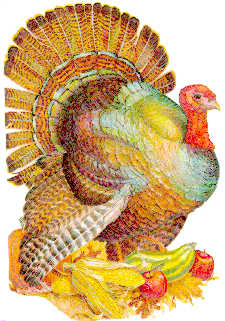Discover the North
American Turkey &
Wild Turkey
|
|
Please Help Pets with a Small Donation of One Dollar
Gobble, Gobble, Gobble goes the Turkeys
The wild turkey of North America is similar to the familiar barnyard
turkey, but slimmer and with rusty tip to tail.
The wild turkey is the species from which all domesticated breeds
have been developed. The bird has buff-colored feathers on the tips
of the wing coverts and on the tail. The male has a long wattle at the
base of the bill and additional wattles on the neck, as well as a prominent
tuft of bristles resembling a beard projecting downward from its chest.
Wild turkeys are good fliers for short distances.
They roost in trees at night.
They feed on acorns, fruit and seeds.
The male or gobbler turkey, calls in the morning to his hens.
Wild Turkey nests are built of dried leaves and grasses in concealed
places on the ground. From 9 to 18 creamy white eggs with red-brown
speckles are laid in a clutch.
The wild turkey was originally domesticated in Mexico, and was
brought into Europe early in the 16th century. Since that time, turkeys
have been extensively raised because of the excellent quality of their
meat and eggs.
North Carolina, Minnesota, and California are the leading states
in turkey production
More information on Turkeys
The Turkey is a large New World bird belonging to the genus
Meleagris. Turkeys are Galliformes in the family
Tetraonidae. There are only two living species of turkeys
left in the world. One of the species is the Oscillated
Turkey, native to Mexico and the Yucatan Peninsula. The
other species is native to North American forests and is
commonly called the Wild Turkey.
The Wild Turkey is a large, dark, bird that can fly but
spends most of its time on the ground. It has long powerful
legs and a large fan-shaped tail. The head and neck are
bare; the bill is short and down curved. The tip of the tail
is brown in the eastern populations and white in the
southwest.
The Wild Turkey is the ancestor of the domestic turkey. The
Wild Turkey was an important food source to the Native
Americans and is still hunted today.
The breast feathers of the male Wild Turkey are tipped with
black and the head and neck are a bluish gray with very pink
wattles. During the spring and mating season the forehead is
white, the face is bright blue, and the neck turns scarlet.
Turkeys have spurs on their legs and a "beard" that becomes
more obvious as they get older.
The female is smaller than the male and has muted brown
plumage that is mottled brown, gray and white. The head is
covered with small feathers and a small beard may be
present. The young Wild Turkey looks similar to the adults.
Both wild and domestic turkeys have a fleshy growth (wattle)
that is unique to the turkey. The wattle hangs loosely from
the bottom of the beak. They also have a "snood," a fleshy
protuberance that hangs from the top of the beak.
Adult Wild Turkeys have a wingspan of almost six feet and
the turkey is the largest bird in the open forest in the
areas in which they live. The female turkey (hen), whether
wild or domestic, is smaller than the male (tom) and is less
colorful.
Unfortunately the Wild Turkey was nearly hunted to
extinction in the United States in the Nineteenth Century.
But the wild turkey has been reestablished in its original
areas and is now successfully established. The hunting of
Wild Turkey is now licensed, limited and monitored like deer
hunting in order to preserve the population, and Wild
Turkeys can again be seen in the woods or on roadsides in
North America.
Picture Domestic Turkey

Turkeys belong to the family Phasianidae of the order Galliformes.
They are sometimes placed in a separate family, Meleagrididae.
Some common breeds of turkey in the United States include:
Bourbon Red
Bronze
Narragansett
White Holland
See Also:
Absolutely Adorable Stuffed Plush Turkeys
Index of North American Birds
Turkey as a Thanksgiving Tradition
All about the Holidays
|